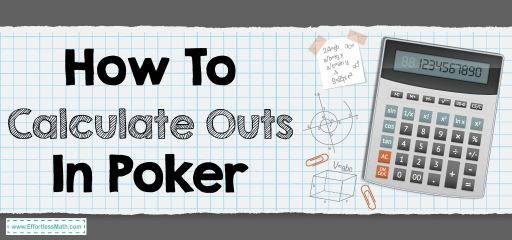How To Calculate Outs In Poker

Knowing how many potential outs you have in poker can help you determine the likelihood of getting the best possible hand in a given situation. This, in turn, helps determine whether you should be betting or folding and what your best strategy is. It’s one of the reasons you’ll see poker players working things out in their heads while deciding whether to bet.
Counting outs is relatively easy in some cases, and it gets easier with practice. It should become an integral part of your poker-playing practice. But, while you might get away with using a poker out calculator while playing online, it’s quicker if you can do the count on the fly, and you certainly won’t be able to use a calculator or chart at the table.
Poker Games
Poker is a popular form of betting in casinos, including the online casinos on this list. It offers excitement, can reward bluffing as well as intelligent play, and you can win significant money if you master the game. Winnings can be further enhanced thanks to bonuses and extras offered by some casinos, according to poker writer Ciaran McEneaney.
What Are Poker Outs?
A poker out is a card that can improve the strength of your hand. Technically, any card that will improve your game is an out, but when calculating outs and odds, we typically only count those that will give us the best hand, or as close to it as possible.
For example, if you hold Ah and 3s, any other 3 could technically improve the strength of your hand, but it is unlikely that a pair of 3s will be the strongest hand in the game. In this instance, an Ace might be considered an out on the flop, but by the time you reach the draw, even a top pair might not be considered good enough.
Because the strength of your hand changes with every card, the number of outs also changes, so you must update and reassess your position throughout the hand.
Once you know how many possible outs you have, you can calculate the odds of getting the card you need to hit the nuts: information that can be used to determine whether you should be playing or folding.
How To Calculate Poker Outs
Before you can work out odds, you need to be able to count poker outs. This means determining how many possible cards can give you a winning hand.
As an example, if you hold hearts and two of the three cards on the flop are also hearts, there are 9 other hearts in the deck. This means you have 9 possible outs, taking into account just the possible flush draw.
But there could be other possible outs. If one of your hearts is an Ace, there are three other Aces in the deck, which means there are 12 outs.
It’s up to you to look at the flop and the number of players to determine whether you consider a top pair of Aces to be good enough to win the hand.
How To Use Poker Outs
Once you know how many outs you have, you can use this to calculate the odds of getting a card you need or calculating equity.
Assume we have a 10h and Kh. The flop is showing 4h, 6h, and Ac. In this case, the flush is the only hand we’re targeting. We’re not looking for another King because our opponent is already betting and we think it’s likely, based on their past play, they have a pair of Aces, so an Ace won’t help us.
There are 9 possible outs from the 47 cards we can’t see in the deck. This gives a 19.16% probability of turning a heart on the turn.
If this card isn’t a heart, we have a slightly better chance of landing a heart on the river because there is one less card, and we are still looking for one of the 9 cards. The odds of turning a heart are now 19.57%. This means, on the flop, the odds of getting a flush are 38.73%.
The Rule Of Two And Four
Working out the odds longhand is virtually impossible during a game. But, there is an easier, albeit marginally less accurate method of doing so, called the rule of two and four. Using this method, you don’t have to be a statistician.
On the flop, you take the number of outs you have and multiply it by four to get your odds. In the flush example above, this would result in approximate odds of 36%.
On the turn, multiply the number of outs by two. For the flush above, this would give odds of 18%. Neither is precisely accurate, but they are close enough.
10 Outs And More
At 9 outs, the deviance from the real odds and the approximate calculated odds is nearly 3%, and the more possible outs you have, the further the estimate will get from the real value. Therefore, if you have ten or more possible outs, you should use a different formula to give a more accurate figure.
Take the number of outs, multiply by four, and subtract the number of outs minus 8.
With 15 possible outs, that gives us (15 x 4) – (15-8) = 60-7 = 53%.
Using the basic formula above, we would have arrived at 60%, and the actual offers are 54.1%.
Dirty Outs
Dirty outs are those that would strictly improve your hand, but they aren’t necessarily worth considering. For example, a pair of 3s is unlikely to win you the pot, so this is a dirty out and shouldn’t usually be considered when calculating equity or odds. Even a top pair is unlikely to win a lot of hands and is unlikely to be the nuts hand.
In these cases, you will need to take into account the cards on display and how your opponents are betting. Use these situational factors to determine what outs are desirable.
Avoiding Replication
In some hands, you have might multiple possible best hands. For example, you could have the possibility of a straight or a flush if you hold a 4h and a 5h and the flop consists of 10h, 6c, 7h. In this case, any 3 or 8 will give you a straight, while any heart will give you a flush.
But, while that looks like 17 possible outs, the 3h and 8h would give you both a straight and a flush, but you can’t count them twice.
Therefore, there are only 15 outs in this hand. That many outs for the nuts hand is still very unusual in poker, and you have a 54% chance of hitting your desired hand.
Conclusion
Poker is a game of numbers, and knowing the odds of getting the cards you need can play a big part in your poker strategy. However, it is only part of the game. Hitting the nuts hand is rare, and many pots are won or lost before the final card is even turned.
Counting your outs and knowing your equity does let you bet with greater confidence, though, and it doesn’t have to be difficult using the rule of 2 and 4.
Frequently Asked Questions
How can I help my child with math anxiety before the test?
To help your child manage math anxiety before a test, begin by ensuring they understand the material through regular practice. Using engaging resources like the Top 10 Grade 3 Math Books Inspiring Young Mathematicians To Explore can make learning more enjoyable and less stressful. Additionally, encourage them to work through various Worksheets to build confidence and familiarity with the types of questions they might encounter on the test. This consistent and fun approach can significantly reduce anxiety by replacing fear with preparedness.
What is the difference between permutations and combinations?
In math, permutations and combinations both refer to different ways of arranging or selecting items, but they are used in distinct scenarios. Permutations consider the order of the items as important, which is similar to considering the sequence of cards in a poker hand where the order can affect the outcome. Combinations, on the other hand, are used when the order does not matter, much like calculating how many possible ways you can select cards for a hand regardless of the sequence. For example, while the combination of cards might be the same, a straight in poker requires a specific permutation of those cards in sequential order. If you’re looking to improve your understanding of mathematical concepts that can also enhance your gaming strategies, check out our resource on permutations and combinations.
How do I help my child prepare for the math test?
To effectively prepare your child for a math test, start by identifying their strengths and areas for improvement within the subject. Utilize resources like the Worksheets from EffortlessMath.com to provide practice on specific topics. Additionally, integrating engaging materials such as books from the Top 10 Grade 3 Math Books Inspiring Young Mathematicians To Explore can make learning more enjoyable and effective. Regular review sessions, tailored to your child’s learning pace, will reinforce concepts and boost their confidence before the test.
Related to This Article
More math articles
- How to Find the Direction of Vectors?
- How to Solve Word Problems of Counting Bills and Coins
- 10 Most Common 3rd Grade ACT Aspire Math Questions
- Algebra Puzzle – Challenge 31
- Top 10 AFOQT Math Prep Books (Our 2023 Favorite Picks)
- Top 10 3rd Grade FSA Math Practice Questions
- How to Interpret Histogram? (+FREE Worksheet!)
- What Are the Applications of the Law of Sines?
- How to Prepare for the ACT Math Test?
- Best Calculators for Linear Algebra and Calculus






































What people say about "How To Calculate Outs In Poker - Effortless Math: We Help Students Learn to LOVE Mathematics"?
No one replied yet.